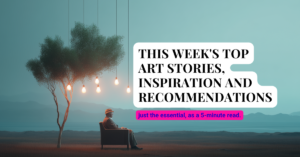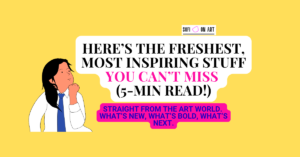This week, F. Scott Fitzgerald’s The Great Gatsby celebrates its 100th anniversary—once trashed by critics, now a timeless masterpiece. École du Louvre launches its first-ever crowdfunding campaign to support struggling students in Paris. Juilliard School announces a $550 million campaign to go tuition-free, making elite arts education more accessible. New music and more.
TOP 5 ART STORIES THIS WEEK

1. Elite Art Schools: "Art Is Expensive"
This week, two of the world’s top art schools dropped the polite act and went straight to the point: talent doesn’t pay rent.
FRANCE: The Louvre’s Art School Is Asking for Help, Publicly
The École du Louvre, the training ground for France’s next-gen curators and art historians, just launched its first-ever crowdfunding campaign. Why? Because 1 in 3 students can’t afford to live in Paris, even after getting into one of the most selective art schools in the country.
As director Claire Barbillon puts it: “Despite passing our selective exam, many students can’t study peacefully because of the cost of living.”
- Average rent near campus? €820+ per month
- Some students aren’t eating enough
- Only 29 out of 144 who applied for daily-life bursaries last year got help
The campaign aims to raise up to €150,000 to fund:
- Emergency food + utility aid (€350 per student).
- Housing support grants (€400/month).
- New daily-life scholarships.
They’ve already built a student residence and upped scholarship rates to 38% for first-years, but it’s not enough. Now they’re asking the public to step in.
USA: Juilliard Wants to Go Tuition-Free. Forever.
Across the ocean, The Juilliard School just announced a $550 million fundraising campaign to make tuition 100% free for all students.
Currently, tuition sits at $55,500 per year, and while 29% of students already pay nothing, Juilliard wants to push that number to 100%. They’ve raised $180 million so far, including $130 million from their own board.
The push? Led by Juilliard president Damian Woetzel, who’s been beating the “affordability” drum since 2018. Right now:
- Graduate acting students already pay zero.
- 40% of all students will be tuition-free next year.
- There’s no timeline yet, but the school says it’s going “as fast as we possibly can”
Bonus trivia: Juilliard’s not first: Curtis Institute of Music in Philly has been tuition-free since 1928. (Mic drop.)
The takeaway from this week? The arts may be priceless, but becoming an artist is still painfully expensive. Fortunately, these two schools aren’t waiting for systemic change, but they try to change it themselves.
2. Hilma af Klint Vibes Now in NYC’s Subway
The New York subway just leveled up its energy field. At Grand Central’s 42nd Street/3rd Avenue entrance, Hilma’s Ghost unveiled Abstract Futures – a 600-square-foot glass mosaic that turns your daily commute into a metaphysical journey.
The duo behind the mural, Hilma’s Ghost, is made up of artists Dannielle Bowman and Sharmistha Ray. Inspired by Hilma af Klint, tarot archetypes, and divine feminine symbolism, the piece unfolds in 3 symbolic stages:
The Fool (courage and new beginnings), The Wheel of Fortune (grounding and change), The World (integration and renewal).
Think spiritual GPS meets cosmic color theory. Commissioned by MTA Arts & Design and fabricated by Miotto Mosaic Art Studios, Abstract Futures is a portal. A mystical detour from the Monday grind.
Take a look here.
3. Artist Ai Weiwei Makes Something Big in New York 🗽
Ai Weiwei, one of the world’s most renowned artists and human rights activists, is creating a monumental new artwork in New York City this fall.
His piece will be installed at Four Freedoms Park, a site dedicated to U.S. President Franklin D. Roosevelt and his famous speech about four essential human rights: freedom of speech, freedom of worship, freedom from want, and freedom from fear.
This project marks the first public art commission in the park’s history and is described as a collective artwork, potentially involving contributions from others. It’s part of a new public art initiative by the park, launching with Ai Weiwei’s participation.
Why is Ai Weiwei significant?
In 2009, he created Remembering, an installation using 9,000 school backpacks on the façade of Munich’s Haus der Kunst to commemorate children who died in the 2008 Sichuan earthquake. The backpacks spelled out the sentence: “She lived happily for seven years in this world”.
In 2011, Ai Weiwei was detained by Chinese authorities for 81 days without formal charges, following his criticism of the government’s policies. Upon release, he was subjected to surveillance and travel restrictions.
His artwork often includes provocative elements, such as his Study of Perspective series, where he photographs his extended middle finger in front of various global landmarks.
Ai has also created sculptures of surveillance cameras and other objects to comment on issues of privacy and state control.
Given his history, it’s expected to be thought-provoking and impactful.
P.S. (On the image above: Dropping a Han Dynasty Urn is a photographic artwork created by Ai Weiwei in 1995. Composed of three 148 by 121 cm black-and-white photographs, it documents Ai holding, dropping, and standing over the remains of a Han dynasty urn that was approximately 2,000 years old.)
👉 Architect’s Newspaper
HOT TAKE: Art Galleries Need to Change

A New Study Published
The art world is having a moment. Collectors are going digital, buying art online like it’s sneakers. But most galleries? They’re still acting like it’s 1995.
A new report reveals that younger collectors, especially those under 37, are driving the shift. 71% of them are now buying art online, and 80% of those are spending more or the same as they did the previous year. Yet, despite this growing demand, only 44% of galleries display prices for all of their available works online, and a surprising 25% still require buyers to inquire about prices.
📌 The issue is clear: Collectors are eager to buy online, but many galleries are treating their websites as showrooms and educational platforms, not as transparent, transactional spaces. This disconnect is creating friction, especially when it comes to price.
LITERARY CORNER 👓📖

Knausgård Is Back, And So Is the Existential Gut Punch
This fall, Karl Ove Knausgård returns with a new novel about impossible love and impossible life. That’s all we know so far.
Why does Knausgård matter? Because no one else writes like he does. His six-volume My Struggle turned daily life (grocery shopping, fatherhood, grief, shame) into literature so intense it felt dangerous. He made the deeply personal uncomfortably public, and millions couldn’t look away. He’s trying to be honest, and that’s why readers return: for the rawness, the questions, the feeling that someone else has walked into the void and taken notes. Get ready for another round of emotional excavation.
THIS WEEK’S BIRTHDAY PARTY:🎉 Gatsby Turns 100, From Flop to Forever
100 years ago, F. Scott Fitzgerald’s The Great Gatsby was published, and promptly trashed by critics. One even said it made them “bray like a donkey.” But fast forward a century, and it’s one of the most celebrated and beloved novels in American literature!
ARTISTS, UNFILTERED
Painter Eric Fischl’s advice to young artists in 1 minute clip: He says young artists should be “lucky” to have everything they think art is stripped away early on. It’s in that discomfort, he believes, that your real voice begins, not through clarity, but through collapse.
P. S: A surprising note from Denmark: Paper isn’t dead, it’s having a comeback 📰
Here’s a plot twist: after years of shutting down their print editions, more and more media outlets are bringing them back. According to Information, there’s a quiet but clear paper trend in Denmark, where several publishers who had once gone all-digital are now relaunching physical magazines and newspapers.
Why the flip? Readers are craving slower, more tactile media. In a sea of screen-scrolling and algorithm-driven headlines, print offers something human: time to think, a sense of care, and the joy of holding a story in your hands.
As one editor put it, “Paper creates presence.”

Music For Your Studio 🎧
Lorde’s new song “What Was That” – just got released 6 days ago. Have you heard it yet? Nostalgic break-up vibes.
“I’ve never been THIS obsessed with a music video. the 0 budget, shot on iPhone, casual clothes, casual set up, casual scenes. No foundation and little done to her hair. I am OBSESSED” – says one commentator under this video.
That’s it for this week!
Subscribe, if you yet haven’t, and have a lovely time meanwhile. See you again next week!
xx, Helen







